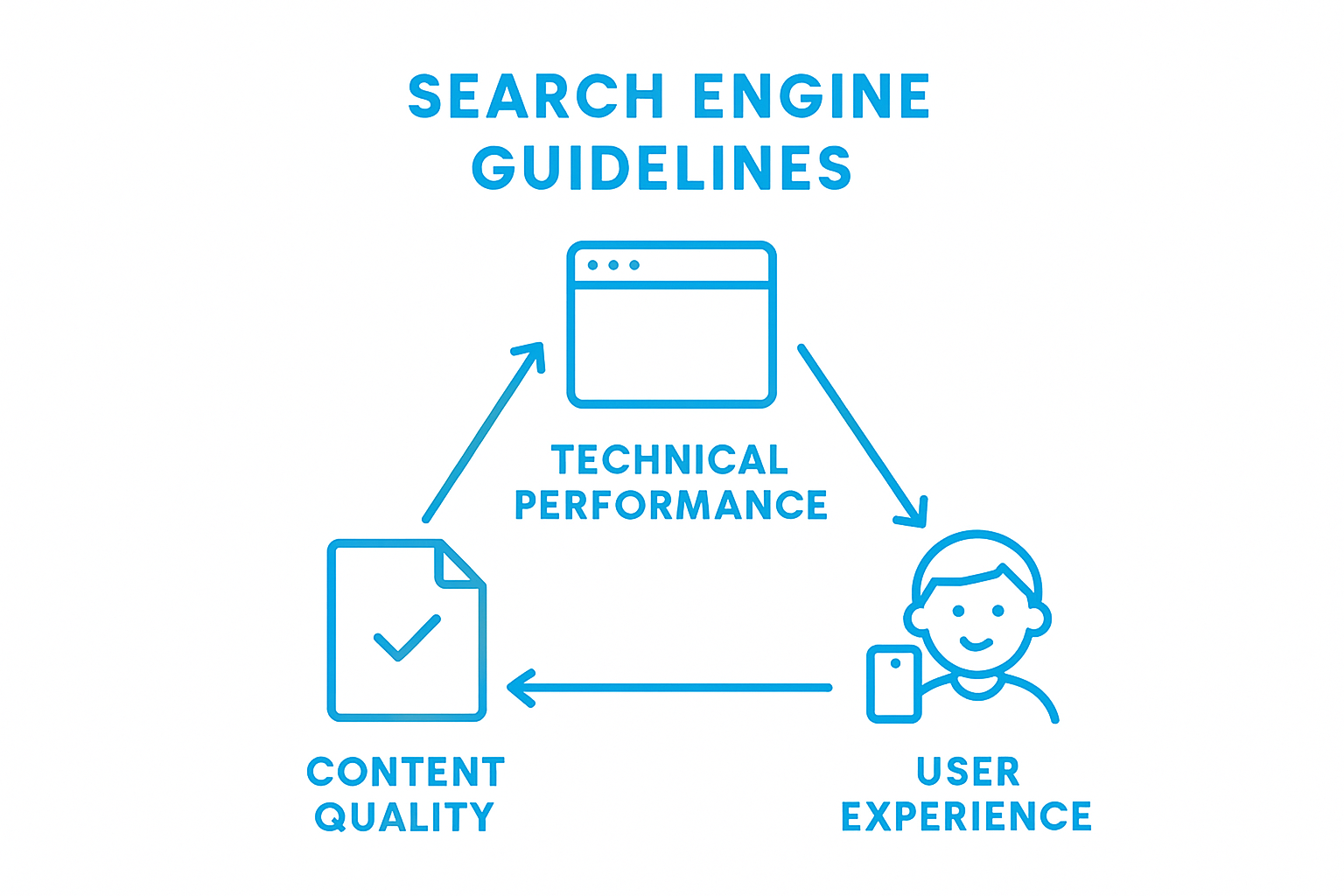Search engine guidelines seem like a bunch of technical rules for websites. But here is what most people miss. These rules are the backbone behind how over 90 percent of people discover new sites and information online. They are not limitations. They are the roadmap that explains how to stand out, avoid search penalties, and build real credibility from the start.
Table of Contents
- What Are Search Engine Guidelines And Their Purpose?
- Why Adhering To Search Engine Guidelines Matters
- How Search Engine Guidelines Influence Search Results
- Key Concepts Within Search Engine Guidelines Explained
Quick Summary
| Takeaway | Explanation |
|---|---|
| Follow search engine guidelines for visibility | Compliance with guidelines ensures better search engine rankings and higher online visibility, helping attract more users to your site. |
| Focus on content quality and relevance | High-quality, relevant content addresses user intent effectively, which search engines reward with higher rankings. |
| Technical performance impacts ranking | Factors like site speed, mobile responsiveness, and HTTPS are crucial for maintaining optimal search rankings and user experience. |
| Avoid manipulative SEO techniques | Using unethical practices can lead to penalties such as lower rankings or removal from search results, harming your brand’s credibility. |
| User experience enhances engagement | A well-designed, navigable site promotes user satisfaction, which can improve engagement metrics that influence search rankings. |
What are Search Engine Guidelines and Their Purpose?
Search engine guidelines represent a comprehensive set of rules and recommendations designed to help websites optimize their online presence and improve their visibility in search results. These guidelines are established by major search engines like Google to ensure a fair, high-quality, and user-centric digital ecosystem.
The Core Purpose of Search Engine Guidelines
Search engine guidelines serve multiple critical objectives that benefit both website owners and users. Their primary purpose is to create a standardized framework that encourages websites to produce high-quality, relevant, and valuable content while maintaining ethical digital practices. Search policy experts at the U.S. Digital Service emphasize that these guidelines are not just technical rules, but strategic frameworks for creating meaningful online experiences.
The key purposes of search engine guidelines include:
- Establishing clear standards for content quality and relevance
- Preventing manipulative SEO techniques that compromise search result integrity
- Promoting user-friendly website design and navigation
- Encouraging transparent and authentic digital communication
Key Components of Search Engine Guidelines
Search engine guidelines typically encompass several fundamental areas that websites must consider. These include technical performance, content quality, and user experience. Each area contains specific recommendations that help websites align with search engine expectations.
The table below outlines the main areas covered by search engine guidelines, with specific examples and how each area impacts a website.
| Area | Example Guidelines/Focus | Impact on Website |
|---|---|---|
| Technical Performance | Site speed, mobile responsiveness, HTTPS, structured data | Improves ranking, accessibility, and user experience |
| Content Quality | Originality, depth, expertise, topical relevance | Enhances credibility, ranking potential, engagement |
| User Experience | Clear navigation, logical structure, accessibility | Boosts satisfaction, lowers bounce rates, retention |

Technical aspects often involve site speed, mobile responsiveness, secure connections (HTTPS), and proper structured data implementation.
Content guidelines focus on originality, depth, expertise, and relevance. User experience considerations address factors like intuitive navigation, clear information architecture, and accessibility.

Learn more about white hat SEO techniques that align perfectly with these comprehensive search engine guidelines, ensuring your digital strategy remains both ethical and effective. By understanding and implementing these guidelines, websites can create a robust online presence that not only ranks well but also genuinely serves user needs.
Why Adhering to Search Engine Guidelines Matters
Adhering to search engine guidelines is not just a recommended practice but a fundamental requirement for any website seeking sustainable online success. These guidelines represent more than technical constraints they are strategic pathways to building credible, user-friendly digital experiences that search engines prioritize and users appreciate.
The Consequences of Non-Compliance
Ignoring search engine guidelines can result in severe penalties that dramatically impact a website’s digital visibility. Search engines like Google employ sophisticated algorithms designed to detect and penalize websites that attempt to manipulate search rankings through unethical practices. Researchers at Stanford University have extensively studied how search engines evaluate website credibility and quality.
The potential consequences of non-compliance include:
This table summarizes the most common consequences websites face if they ignore or violate search engine guidelines.
| Consequence | Description |
|---|---|
| Lower Search Rankings | Website appears lower in search results, reducing visibility |
| Removal from Search Results | Possible temporary or permanent de-listing from search engines |
| Loss of Organic Traffic | Significant decrease in users arriving via search |
| Revenue Decrease | Fewer visitors means lower ad, lead, or sales opportunities |
| Brand and Credibility Damage | Perceivable loss of trust and authority among users and engines |
- Significant reduction in search engine rankings
- Temporary or permanent removal from search results
- Loss of organic traffic and potential revenue
- Damage to brand reputation and digital credibility
Building Long-Term Digital Credibility
Comprehensive adherence to search engine guidelines is about creating a robust digital strategy that transcends short-term ranking manipulations. Websites that consistently produce high-quality, original content and maintain excellent technical infrastructure are more likely to achieve sustainable online success.
Moreover, following these guidelines helps websites create a superior user experience. Mobile responsiveness, fast loading speeds, clear navigation, and secure connections are not just technical checkboxes but critical elements that directly impact user engagement and satisfaction.
Explore our comprehensive guide on SEO ranking factors to understand how strategic alignment with search engine guidelines can transform your digital presence. By viewing these guidelines as a collaborative framework rather than restrictive rules, websites can develop digital strategies that simultaneously satisfy search engine requirements and deliver genuine value to users.
How Search Engine Guidelines Influence Search Results
Search engine guidelines function as intricate algorithmic frameworks that fundamentally shape how websites are discovered, ranked, and presented in search results. These guidelines transform complex digital interactions into meaningful, relevant user experiences by establishing precise criteria for content evaluation and presentation.
Content Relevance and Quality Assessment
Search engine guidelines create sophisticated mechanisms for assessing content quality and relevance. Search algorithms analyze multiple dimensions beyond simple keyword matching, examining factors like content depth, expertise, user engagement, and contextual accuracy. Researchers at Stanford University have demonstrated how these nuanced evaluation processes determine a webpage’s visibility and ranking potential.
Key content assessment criteria typically include:
- Originality and unique information value
- Comprehensiveness and topic expertise
- User engagement metrics
- Contextual relevance to search intent
Technical Infrastructure and Ranking Signals
Beyond content quality, search engine guidelines significantly influence results through technical infrastructure evaluation. Websites must meet specific technical standards to achieve optimal search visibility. Mobile responsiveness, page loading speed, secure connections, and structured data implementation become critical ranking signals.
These technical guidelines ensure that search results prioritize websites offering superior user experiences. By establishing clear technical benchmarks, search engines incentivize continuous digital infrastructure improvements that benefit both users and website owners.
Learn more about how search algorithms work to gain deeper insights into the intricate processes driving search result presentations. Understanding these guidelines helps websites strategically align their digital strategies with search engine expectations, ultimately improving their online visibility and user engagement.
Key Concepts Within Search Engine Guidelines Explained
Search engine guidelines represent a sophisticated ecosystem of interconnected principles designed to ensure digital content quality, relevance, and user experience. Understanding these key concepts provides website owners and content creators with a strategic framework for achieving optimal online visibility and engagement.
Content Quality and Semantic Relevance
Content quality transcends simple keyword optimization, focusing instead on delivering comprehensive, authoritative information that genuinely addresses user intent. Search engine guidelines emphasize semantic relevance, which means creating content that comprehensively explores a topic rather than merely targeting specific search terms. Researchers from Stanford University highlight how advanced algorithms now assess content depth and contextual understanding.
Critical content quality considerations include:
- Demonstrating subject matter expertise
- Providing unique, original insights
- Maintaining logical content structure
- Addressing multiple user search intents
Technical Infrastructure and Performance Metrics
Search engine guidelines place significant emphasis on technical performance as a crucial ranking factor. Websites must meet rigorous technical standards that ensure seamless user experiences across diverse digital platforms. This includes mobile responsiveness, rapid page loading speeds, secure connections, and clean, semantic HTML structures.
Technical performance metrics encompass various elements like site architecture, page speed, mobile compatibility, and structured data implementation.
The following table compares key concepts from search engine guidelines by summarizing their focus and benefits to websites.
| Concept | Focus Area | Website Benefit |
|---|---|---|
| Content Quality & Semantic Relevance | Comprehensive, original, expert content matching user intent | Better rankings, credibility, relevance |
| Technical Infrastructure & Performance | Site speed, mobile compatibility, secure connections, structure | Improved user experience, increased engagement |
| These guidelines incentivize continuous technological improvement, pushing websites to create more efficient, user-friendly digital experiences. |
Explore the fascinating history of search engine milestones to understand how these guidelines have evolved. By comprehending these key concepts, digital professionals can develop strategic approaches that align with search engine expectations, ultimately enhancing their online visibility and user engagement.
Ready to Turn Search Engine Guidelines into SEO Wins?
Staying compliant with search engine guidelines sounds good in theory, but actually putting these strategies into practice feels complex, especially when keyword cannibalization threatens your rankings. If you have ever worried about duplicate content, confused site architecture, or lost organic traffic, you are not alone. Missing the mark on technical performance or creating overlapping content can leave your website invisible to both algorithms and users. Fortunately, you can take control now using trusted tools designed to solve these exact challenges.
Stop letting compliance worries or internal competition hold your website back. Discover how the #1 Keyword Cannibalization Tool at RankAligner helps SEO consultants and agencies align site structure with best practices from our SEO ranking factors guide. Take advantage of real solutions that help you turn search engine guidelines into actionable steps for online growth. Visit RankAligner today to secure your visibility and drive qualified traffic before your competitors can catch up.
Frequently Asked Questions
What are search engine guidelines?
Search engine guidelines are a set of rules and recommendations established by search engines like Google to help websites optimize their content and visibility in search results. They focus on creating high-quality, user-centric web experiences.
Why is it important to follow search engine guidelines?
Adhering to search engine guidelines is crucial for achieving sustainable online success. It helps improve a website’s ranking, maintains credibility, and enhances user experience, ultimately leading to increased organic traffic and revenue.
What can happen if a website ignores search engine guidelines?
Ignoring search engine guidelines can lead to penalties such as significant drops in search engine rankings, temporary or permanent removal from search results, loss of organic traffic, and damage to a website’s brand reputation.
What key areas do search engine guidelines cover?
Search engine guidelines typically cover technical performance (like site speed and mobile responsiveness), content quality (such as originality and expertise), and user experience (including navigation and accessibility) to ensure comprehensive optimization.

